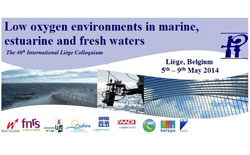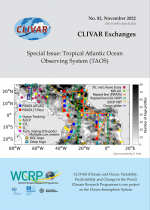46th International Liege Colloquium on Ocean Dynamics
Submitted by admin on Wed, 2014-03-05 11:50


Low Oxygen Environments In Marine, Estuarine And Fresh Waters
University of Liège, Belgium
5 - 9 August 2014
The 46th Liege colloquium will investigate new developments and insights related to the critical problem of ocean deoxygenation, low oxygen zones in marine and freshwater systems.
Deadlines:
24th January 2014: submission of abstracts
21th February 2014: decision of the Scientific organizing committee of accepted abstracts
7th March 2014: preliminary program will be sent to registered participants.
More specifically, the following topics will be considered:
- Oxygen time series and instrumental developments: How to optimize the spatial and temporal coverage of oxygen survey, through which autonomous in situ sensors and platforms? How to refine our estimations of the different terms in the oxygen budget: benthic oxygen demand, surface fluxes, photosynthesis/respiration balance? Which sensors for detecting nanomolar levels of oxygen? Could an early monitoring allow reacting and adapting management strategies when a year of strong hypoxia is foreseen?
- Deoxygenation in various systems: Inland aquatic systems (lakes and ponds, fjords and bays, rivers and estuaries, inland seas, etc.), coastal and off-shore marine systems (OMZs in EBUSs, marine shelves, open marine systems and oceans). What are the differences and similarities between these systems, which drivers are important and what consequences are observed/expected on different spatio-temporal scales?
- Deoxygenation, marine resources and structure of the foodweb: sensitivity, resistance, resilience and recovery of marine resources (e.g. benthic organisms, fishes), what are the important factors (e.g. duration and frequency of the hypoxic event, stage of development of the organism)? Adaptation of biocenoeses to low oxygen levels (difference between communities exposed to permanent hypoxic areas over many millennia with those recently exposed), modification of the traits of the community in regions recently affected by hypoxia, how to define an index of hypoxia severity that quantifies its impacts on the living organisms and ecosystem services? By removing some components of the trophic web and modifying the cycling of essential elements oxygen deficiency may change the structure of the foodweb.
- Deoxygenation and biogeochemical cycles. Oxygen availability impacts on biogeochemical cycles both directly and indirectly. In oxygen deficient waters, the degradation of organic matter requires the use of alternate final electron acceptors (e.g. NO3, MnO2, Fe(OH)3, SO4, CO2) changing the balance of chemical elements (e.g. N, C, P). Microbial communities can form consortia that lead to the coupling of several processes and elements such as anaerobic CH4 oxidation that can be coupled to sulfate-reduction, iron-reduction, denitrification. Also oxygen deficiency alters the cycling of major chemical elements by, for instance, controlling the loss of fixed N via denitrification and anammox in the water column and the sediments, and causing the remobilization of P bound to iron oxides in the sediments. In addition, as it affects the living communities in general deoxygenation may change the ability of the system to sequestrate carbon dioxide with eventual links to the acidification dynamics. Finally, Oxygen Minimum zones are key regions in the climatic gas budgets such as CO2, N2O, CH4, DMS, halogenated compounds impacting on climate variability.
- Meromictic systems, oxic-anoxic interfaces, and microorganisms: In meromictic environments, C, N and S cycles may be strongly coupled, due to different microbial activities, involving archaea and bacteria. The varying nature of the processes taking place raises many questions, such as which denitrification process prevail and why, which is the contribution of autotrophic microorganisms such as methanotrophs and nitrifiers to organic carbon production and ecosystem productivity, etc. The Baltic and Black Seas, and deep tropical lakes (L. Tanganyika, L. Kivu), and reservoirs are water bodies in which these microbial processes driving biogeochemical cycles are being studied.
- The development of models able to identify and disentangle the mechanisms (physical versus biogeochemical), drivers (climate versus land use impact), spatial and temporal variability (from the coastal to the deep ocean) of ocean deoxygenation. Which tools can be used to provide recommendations to local environmental authorities in relation to management strategies of river discharges for controlling the level of bottom hypoxia? Which strategies can be developed to value information provided by the large scale models (IPCC class)?
- Paleoproxies of hypoxia (e.g. foraminifera, ostracods, sediment texture, chemical and mineral composition): Which (paleo)-proxies (biological, mineralogical, chemical) can be used to reconstruct the long term history of hypoxia and to establish pre-impacted baselines? The evolution of hypoxia in the coastal ocean can be inferred from microfossils, biomarkers and the chemical and mineralogical composition of bottom sediments. However, accurate quantitative proxies for palaeo-oxygenation remain elusive and distinguishing the effects of hypoxia from those of eutrophication without DO-depletion poses a considerable challenge. Among the biomarkers; pigments from anoxygenic photosynthetic bacteria, preserved in sediments, are excellent indicators of anoxic conditions in the past.
- Deoxygenation in a global change context: impacts of natural variation, global change and land use on oxygen depletion. In the future, the temperature rise will tend to increase hypoxia by enhancing the metabolism of organisms, reducing the oxygen solubility in the water column and reducing the ventilation by increasing the stratification. As most of the effects of climate change on the local scales are as most of the effects of climate change on the local scales are not well understood, strongly adaptive management strategies of the river discharges are required to restrain the damages of hypoxia on the ecosystems.
Keynotes (already accepted):
Nancy Rabalais (accepted)
Lothar Stramma (accepted)
Robert Diaz (accepted)
Rutger Rosenberg (accepted)
Silke Severmann (accepted)
Eugene Turner (accepted)
Dubravko Justic (accepted)
Klaus Jurgens (accepted)
Zouhair Lachkar (accepted)
Niels-Peter Revsbech (accepted)
James Murray (accepted)













